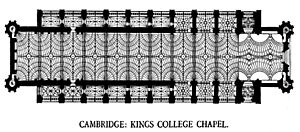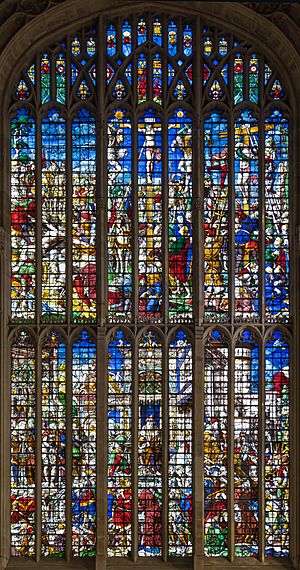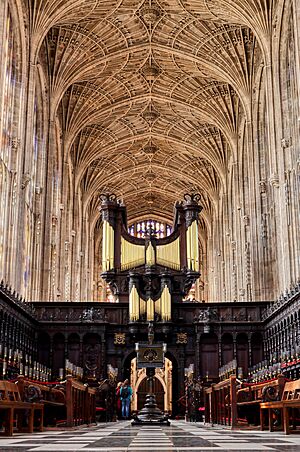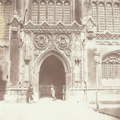King's College Chapel, Cambridge facts for kids
Quick facts for kids King's College Chapel |
|
|---|---|
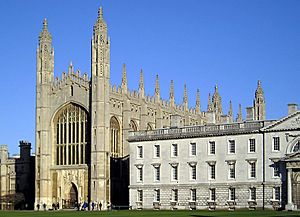
King's College Chapel (partly obscured by the Gibbs' Building) seen from The Backs
|
|
| 52°12′17″N 0°06′59″E / 52.2048°N 0.1165°E ACoordinates: Extra unexpected parameters |
|
| Location | Cambridge |
| Country | England |
| Denomination | Church of England |
| Previous denomination | Roman Catholic |
| History | |
| Status | Collegiate chapel |
| Dedication | Our Lady and Saint Nicholas |
| Consecrated | 1443 |
| Architecture | |
| Functional status | Active |
| Heritage designation | Grade I listed |
| Designated | 26 April 1950 |
| Architect(s) | Disputed |
| Architectural type | Church |
| Style | English Gothic |
| Years built | 1446–1515 |
| Specifications | |
| Length | 289 feet (88 m) |
| Width | Vault: 40 feet (12 m) |
| Height | Interior: 80 feet (24 m) Exterior: 94 feet (29 m) |
| Number of spires | 4 |
King's College Chapel is a famous chapel at King's College in the University of Cambridge in England. It is known as one of the best examples of late Perpendicular Gothic style. This is a type of English architecture with tall, straight lines. The Chapel also has the world's largest fan vault, which is a special kind of ceiling.
Many kings of England helped build the Chapel. Construction started in 1446 and finished in 1515. This time included the Wars of the Roses, a series of battles for the English throne. The Chapel's beautiful stained glass windows were finished by 1531. Its early Renaissance rood screen, a wooden screen separating parts of the church, was put up between 1532 and 1536. Today, the Chapel is still used for worship. It is also home to the famous King's College Choir. The Chapel is a well-known symbol of the city of Cambridge.
Contents
Building the Chapel: A Royal Project
King Henry VI wanted to build a university chapel that was similar to the one at Eton College. He decided how big the Chapel should be. Reginald Ely was likely the main architect. He started working on the site in 1446. Two years earlier, Reginald was asked to find skilled workers for the Chapel. He continued working until 1461 when building stopped. He probably designed the main parts of the building.
The first plans were for a simpler ceiling design. However, a much more complex fan vault was built instead. Reginald might have designed the special window patterns at the far east of the Chapel. These patterns are in a curvilinear Gothic style, which is different from the straight lines of the Perpendicular style. A priest named Nicholas Close was in charge of overseeing the building. He was the priest of a church that was taken down to make room for the Chapel.
King Henry VI himself laid the first stone of the Chapel on July 25, 1446. The College itself had started in 1441. By the end of King Richard III's rule in 1485, five sections of the Chapel were done. A wooden roof was also put in place. This was impressive, considering the country was in the middle of the Wars of the Roses.
King Henry VII visited in 1506. He paid for the work to start again. He even left money so that building could continue after he passed away. In 1515, during the time of King Henry VIII, the main building was complete. However, the large windows still needed to be made.
The Chapel has the world's largest fan vault. This amazing ceiling was built between 1512 and 1515 by a master builder named John Wastell. The Chapel also has beautiful medieval stained glass.
The Rubens Painting and Its Journey
Above the altar is a famous painting called The Adoration of the Magi. It was painted by Peter Paul Rubens in 1634. The painting was originally made for a convent in Belgium. It was placed in the Chapel in 1968. This caused some debate at the time. To fit the painting, the floor near the High Altar had to be lowered.
During this work, old brick arches from the Tudor period were found. These arches were part of the original design. Human remains in lead coffins were also discovered. These dated from the 15th to 18th centuries and were moved.
Putting the Rubens painting in place also had challenges. Its bright colors seemed to clash with the stained glass window above it. The painting was also a similar shape to the window, making it look small. To fix this, plain shutters were added on each side. This made the painting look like a triptych, giving it its own special shape. Sir Martyn Beckett designed this setup. He was happy that people eventually accepted this solution.
Surviving Wars and Time
Many religious places were damaged during the English Civil War. This was because Puritans wanted to remove or destroy religious images they didn't like. However, King's College Chapel was mostly unharmed. Even though Parliamentarian soldiers used it for training, the building was largely untouched. Some people believe that Oliver Cromwell, who had studied in Cambridge, ordered it to be protected. You can still see graffiti left by soldiers near the altar.
During the Second World War, most of the Chapel's stained glass was stored away for safety. Luckily, the Chapel was not damaged during the war.
Amazing Stained Glass Windows
The windows in King's College Chapel are some of the best from their time. There are 12 large windows on each side of the Chapel. There are also bigger windows at the east and west ends. Most of these windows were made by Flemish artists between 1515 and 1531.
Barnard Flower, who was the first non-English King's Glazier, finished four windows. Galyon Hone and three partners made the east window and 16 others. This work happened between 1526 and 1531. The last four windows were made by Francis Williamson and Symon Symondes. The only modern window is on the west wall. It was given by a former student, Francis Stacey, and made by the Clayton and Bell company in 1879.
The Beautiful Rood Screen
This large wooden screen separates the front part of the Chapel from the main choir area. It also holds the organ. King Henry VIII had it built between 1532 and 1536. He did this to celebrate his marriage to Anne Boleyn.
The screen is an early example of Renaissance architecture. It looks very different from the older Perpendicular Gothic style of the Chapel. Sir Nikolaus Pevsner, a famous expert on buildings, said it is "the most exquisite piece of Italian decoration surviving in England."
How the Chapel is Used Today
The Chapel is still an active place of worship. It is also used for concerts and other college events. One popular event is the annual King's College Music Society May Week Concert. This concert is held in May and is enjoyed by students, former students, and visitors.
The Chapel is famous for its amazing sound quality. The world-renowned Choir of King's College, Cambridge sings here. The choir includes male students from the college and boys who attend the nearby King's College School. Sir Stephen Cleobury was the director of music for the choir from 1982 until he passed away in 2019. Currently, Daniel Hyde leads the choir. The choir sings services most days during term time. They also perform concerts, make recordings, and are broadcast on TV and radio.
The BBC has broadcast the Choir's Nine Lessons and Carols from the Chapel on Christmas Eve for many years. During this service, a young boy with a treble voice sings the first verse of Once in Royal David's City. There is also another chapel choir called King's Voices. This choir is made up of male and female students. They sing Evensong on Mondays during term time.
The Chapel is widely recognized as a symbol of Cambridge. For example, it is featured in the logo of Cambridge City Council.
Images for kids
-
King's College Chapel, Cambridge, South Entrance, by Henry Fox Talbot, c. 1845
-
Landscape painting of the Chapel by Thomas Malton, dated 1798
See also
 In Spanish: Capilla del King's College para niños
In Spanish: Capilla del King's College para niños



